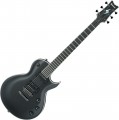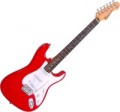Pickup diagram
Electric guitar pickup layout diagram. The letters used in this diagram indicate the types of pickups:
-
S - single. A single-coil pickup that looks like a narrow strip, often with a number of “buttons” (magnets) corresponding to the number of strings. Such modules provide clear and ringing sound, well suited for jazz, blues and other similar genres. On the other hand, the sound saturation from single-coils is not very high; they are poorly compatible with distortion and other similar effects, which is why they are poorly suited for “heavy” styles of music. In addition, such pickups are susceptible to external magnetic fields, which can degrade the sound.
-
H - humbucker. A type of pickup with two coils, originally created to compensate for the shortcomings of single coils - in particular, to reduce the level of interference from external magnetic interference. However, in the end it turned out that humbuckers differ noticeably in the color of the sound: it turns out to be less expressive, but more dense and rich, making it excellent for playing “overload” (distortion, overdrive, etc.). A classic pickup of this type has two coils positioned side by side, making it noticeably wider than a single coil; and Standard class humbuckers generally look like two single coils installed close to each other. However, in addition to this, there are other design options - for example, a hamcanseller
..., which has coils “on two levels” and is comparable in width to a single. Also note that there are humbuckers that can switch to single-coil mode (see “Coil Cutoff” for more details).
—J. A subtype of S-type pickups with one coil and an additional pole for each string. This variety first appeared on the legendary Fender Jazz Bass. J pickups have a versatile sound that suits almost any style of music.
—P. P pickups have two magnetized poles per string, but they have a unique feature: they are cut in half and wound in reverse. The advantage of this winding is the humbucker effect (see type “H”). The wide and long shape of the P pickup provides powerful and punchy sound in genres such as rock, metal, punk, etc.
- P90. A special type of single-spool single with a wider but shorter bobbin. These pickups are installed in the bridge or neck area of the guitar. Their distinctive feature is a characteristic “rock and roll” sound with warm, soft and rich timbres. Instruments with P90 pickups are often used in alternative rock, blues, indie, etc. styles.
The pickup diagram describes their types, number and relative positions. Our catalog uses a bridge-to-neck designation: for example, an HSS design means the guitar has one humbucker at the bridge and two single-coils near the neck.
This parameter determines, first of all, the overall color of the instrument’s sound. Thus, the above version of HSS will produce a sound that is quite clean and expressive, but at the same time a little denser and lower than on a purely “single-coil” electric guitar. There are many models available that are equipped with only one type of pickups. Moreover, the more pickups, the deeper and richer the sound, as a rule. In addition to all this, many other factors affect the sound of the instrument, so when choosing, you should not look only at the pickup circuit.Volume controls
The number of volume controls provided in an electric guitar.
If there is only one knob, this means that the musician can only adjust the overall volume of the instrument. However, there are models that have several volume control knobs — usually there are no less of them than pickups (2 or 3), which allows you to separately adjust the volume of each pickup. And since the characteristics of the sound depend on the type of the used pickup (see "Pickup Diagram") and even its location, then by changing the mutual volume of the individual pickups, you can achieve different coloring of the sound. At the same time, the design may also include a general volume control, which allows you to adjust it in the classical way and not mess with the settings of each pickup.
Tone controls
The number of tone controls provided in the design of an electric guitar.
One tone control is responsible for the sound of the electric guitar as a whole; but if there are several such pens, they can have different formats of work. So, each knob can be responsible either for its own pickup, or for a separate frequency band. In the second case, a set of knobs plays the role of an equalizer that allows you to adjust the sound by changing the volume of low and high (sometimes even separately middle) frequencies.
Anyway, the presence of several tone controls expands the possibilities for changing the coloring of the sound by means of the guitar itself, without the use of additional equipment.
Pickup switch
A type of pickup switch used on an electric guitar.
This switch is responsible for turning individual pickups on and off, and can also control coil cutoff (see above). Accordingly, the manufacturer chooses its type primarily depending on the number of pickups (see "Pickup Diagram"). So, 3-position switches are typical mainly for models with two pickups — they usually allow you to turn on each of them separately or use both at once. The 5-position controls are common on 3-pickup models with stratocaster or superstrat bodies (see “Shape (Appearance)”). Note that the specific combinations of pickups available in such instruments may be different, this point will not hurt to clarify separately. The most advanced option — a 6-position switch — is extremely rare, mainly in expensive custom class instruments.
A separate type of switch is the balance control, used mainly in bass guitars (see "Type"). They are not responsible for turning off individual pickups (there are usually two of them), but for changing their volume relative to each other. Roughly speaking, these are two volume controls for separate pickups, combined in one knob (of course, there are also two pickups in such instruments). In fact, the balance control in this case also provides a smooth change in timbre: the pickup near the bridge picks up high frequencies better, the pickup near the fretboard picks up lower frequencies, respectively, and the colour of the sound changes depending on which of t...hem sounds louder.
Shape
The general shape of the body of an electric guitar.
The solid body of an electric guitar can be molded into almost any shape; hollow cases do not give such freedom, however, even among them, the options in shape can be very diverse. However, there are certain standard forms. It is not uncommon for these shapes to be named after a particular "legendary" guitar model, such as the "Les Paul" or "Stratocaster" (after Gibson and Fender instruments of the same name, respectively). It makes no sense to describe each standard form — it's easier to find an illustration in our catalog or on the Internet.
The main, and often the only point, which is affected by the shape of the body is the appearance of the guitar. Also, convenience for the musician to some extent depends on this parameter — for example, some models allow you to play while sitting, resting the instrument on your foot, for others this method is weak or not suitable at all. But whether the shape of the body affects the sound of an electric guitar is a moot point. There is an unequivocal dependence only in semi-acoustic models, but for solid bodies there is no clear answer to this question: some musicians claim the superiority of some forms over others, but this moment is largely subjective. In addition, other parameters (types and number of pickups, bridge design, etc.) greatly affect the sound quality.
Now on the market there are guitars with this body shape:
Les Paul,
Superstrat,
Stratocaster,
Jazz Bass,
Precision Bass,
Telecaster,
PRS Santana,
Flying V,
SG, however, there are also completely
non-standard options.
Cutaway
A type of cutout provided in the construction of a guitar body.
The notch is located at the point where the neck is attached to the body and can be
single or
double. The single cutout for a standard guitar hold is on the bottom, under the neck. It is designed to allow the player to comfortably use the higher (closer to the bridge) frets without the body getting in the way of the left hand (or right, in a left-handed instrument). In models with a double cutout, there is also a notch above the neck, it may be smaller than the bottom one. The top notch is provided mainly for aesthetic purposes, to give the instrument a distinctive appearance, but it can also be useful in fact — for example, if the player uses his thumb to hold the frets.
Note that some variants of the body shape do not provide cutouts at all — this is simply not required. Flying B body guitars are an example.
Pickguard
The presence of a protective lining (pickguard) on the body of the guitar.
Such an overlay is located on the upper deck, most often made of durable plastic and differs markedly in colour, due to which it is clearly visible. Its main purpose is to protect the soundboard surface from pick strikes (for example, when playing with dynamic fighting), which could damage the varnished wooden surface. The specific shape and size of the fingerboard may vary, but anyway, it covers at least the surface below the strings (when looking at the guitar in the working position), and sometimes under the strings and even above them.
Material
The material from which the body of an electric guitar is made. For models with cutouts (semi-acoustic, see "Type"), in this case, only the material of the back deck and sides can be taken into account, and data on the top deck is given separately (for more details, see "Deck Cover Material").
Now on the market there are cases of such trees:
red,
maple,
agatis,
ash,
alder.
It makes no sense to dwell on each of the materials found in modern electric guitars. Their variety is very large, however, unlike acoustic guitars, the body in this case does not play such a significant role in shaping the sound, and its material has a relatively small effect on the acoustic properties of the instrument (although the exact degree of such influence is a moot point). If you wish, you can find detailed data on a particular material in special sources, but in fact it makes sense to look primarily at the appearance of the instrument and its price category.
Body top
The material from which the soundboard cover is made is an additional overlay on the upper soundboard, which primarily plays a decorative role and gives the instrument a pleasant appearance. Do not confuse such a cover with a protective overlay (see above about it). And in semi-acoustic instruments with a hollow body (see "Type"), this paragraph may indicate the material of the upper soundboard, and a separate cover as such may be absent.
In general, the value of this parameter is similar to the material of the body (see above) — adjusted for the fact that the deck cover also directly determines the appearance of the electric guitar, and in semi-acoustic models it affects the sound more than the rest of the body. However, the main criterion for choosing this parameter may well be the aesthetic preferences of the musician.

